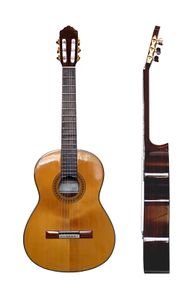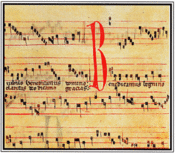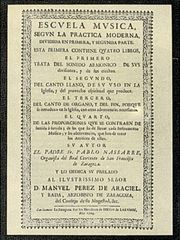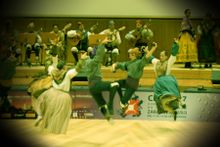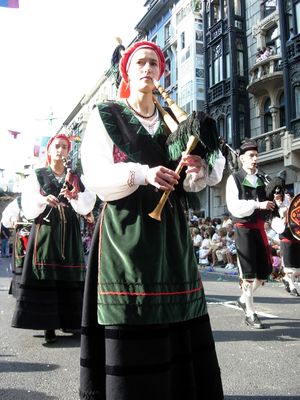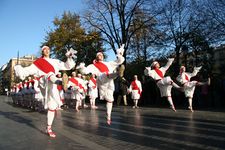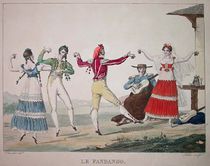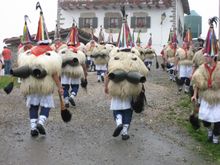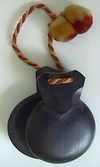موسيقى إسپانيا
موسيقى إسپانيا لها تاريخ طويل وقد لعبت دورا هاما في تطوير الموسيقى الغربية. وكان لها تأثير قوي خاصة على موسيقى أمريكا اللاتينية. وكثيرا ما ارتبطت الموسيقى الإسپانية في الخارج بموسيقى تقليدية مثل الفلامنكو والگيتار الكلاسيكي لكن الموسيقى الإسپانية، في حقيقة الأمر، تختلف من منطقة لأخرى. الفلامنكو على سبيل المثال، هو نوع من الموسيقي الأندلسية من جنوب إسپانيا. على العكس، نجد أن موسيقى المناطق الشمالية الغربية تركز على استخدام القرب، بينما تتمتع منطقة الباسك بموسيقها التقليدية الخاصة بها، التي تختلف عن موسيقى أراگون، كتالونيا، بلنسية، قشتالة وليون. لعبت إسپانيا أيضا دورا هاما في تاريخ الموسيقى الكلاسيكية الغربية، خاصة في المرحلة المبكرة من من القرن 15 حتى القرن 17؛ مع مؤلفين مثل توماس لويس ده ڤيكتوريا حتى الاوپرا الإسپانية زارويلا أو الباليه العاطفي مانويل ده فالا وعازف الگيتار پيپه رومرو. في الوقت الحالي، تقدم الموسيقى الإسپانية جميع الأنواع الموسيقية الشعبية التجارية.
. . . . . . . . . . . . . . . . . . . . . . . . . . . . . . . . . . . . . . . . . . . . . . . . . . . . . . . . . . . . . . . . . . . . . . . . . . . . . . . . . . . . . . . . . . . . . . . . . . . . . . . . . . . . . . . . . . . . . . . . . . . . . . . . . . . . . . . . . . . . . . . . . . . . . . . . . . . . . . . . . . . . . . . .
أصول موسيقى إسپانيا
التاريخ المبكر
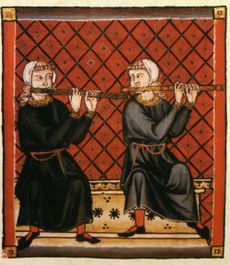
الموسيقى الأندلسية
The Moors of Al-Andalus were usually relatively tolerant of Christianity and Judaism, especially during the first three centuries of their long presence in the Iberian peninsula, during which Christian and Jewish music continued to flourish. Music notation was developed in Spain as early as the eighth century (the so-called Visigothic neumes) to notate the chant and other sacred music of the Christian church, but this obscure notation has not yet been deciphered by scholars, and exists only in small fragments. The music of the early medieval Christian church in Spain is known misleadingly as the "Mozarabic Chant". The chant developed in isolation prior to the Islamic invasion and was not subject to the Papacy's enforcement of the Gregorian chant as the standard chant around the time of Charlemagne, by which time the Muslim's had conquered most of the Iberian peninsula. As the Christian reconquista progressed, these chants were almost entirely replaced by the Gregorian standard, once Rome had regained control of the Iberian churches. The style of Spanish popular songs of the time is presumed to have been heavily influenced by Moorish music, especially in the south, but as much of the country still spoke various Latin dialects while under Moorish rule (known today as Mozarabic) earlier musical folk styles from the pre-Islamic period continued in the countryside where most of the population lived, in just the same way as the Mozarabic Chant continued to flourish in the churches. In the royal Christian courts of the reconquistors, the music, like the Cantigas de Santa Maria, also absorbed Moorish influences. Other important medieval sources include the Codex Calixtinus collection from Santiago de Compostela and the Codex Las Huelgas from Burgos. The so-called Llibre Vermell de Montserrat (red book) is an important devotional collection from the 14th century.
النهضة والباروك
في أوائل عصر النهضة، كان ماتيو فلچا إل بيخو والكاتب المسرحي القشتالي خوان دل إنكينا من أوائل المؤلفين الموسيقيين في فترة ما بعد آرس نوڤا. بعض ترانيم عصر النهضة are the Cancionero de Palacio, the Cancionero de Medinaceli, the Cancionero de Upsala (محفوظة في مكتبة كارولينا رديبيبا)، كانشينيرو ده لا كولومبينا، وفيما بعد كانشينيرو ده لا سابلونارا. عازف الأورگ أنطونيو ده كابزون stands out for his keyboard compositions and mastery.
القرن 18-20
هل لديك مشكلة في تشغيل هذا الملف؟ انظر مساعدة الوسائط.
الموسيقى حسب المنطقة
الأندلس
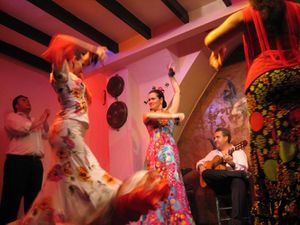
Though Andalusia is best known for flamenco music, there is also a tradition of gaita rociera (tabor pipe) music in western Andalusia and a distinct violin and plucked-string type of band music known as panda de verdiales in Málaga.
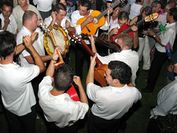
Sevillanas is related to flamenco and most flamenco performers have at least one classic sevillana in their repertoire. The style originated as a medieval Castilian dance, called the seguidilla, which was increasingly "flamenconized" from the late 18th century and through the 19th century in parallel with the appearance and evolution of flamenco. Today, this lively couples' dance is popular in most parts of Spain, though the dance is often associated with the city of Seville's famous Easter feria.
The region has also produced singer-songwriters like Javier Ruibal and Carlos Cano, who revived a traditional music called copla. Catalan Kiko Veneno and Joaquín Sabina are popular performers in a distinctly Spanish-style rock music, while Sephardic musicians like Aurora Moreno, Luís Delgado and Rosa Zaragoza keep alive-and-well Andalusian Sephardic music.
أراگون
أستورياس، كانتابريا، وجليقية
. . . . . . . . . . . . . . . . . . . . . . . . . . . . . . . . . . . . . . . . . . . . . . . . . . . . . . . . . . . . . . . . . . . . . . . . . . . . . . . . . . . . . . . . . . . . . . . . . . . . . . . . . . . . . . . . . . . . . . . . . . . . . . . . . . . . . . . . . . . . . . . . . . . . . . . . . . . . . . . . . . . . . . . .
بلاد الباسك
قشتالة ومدريد وليون
قطلونيا
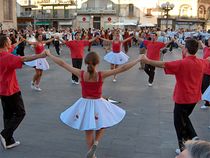
ناباره ولا ريوخا
يي-يي
المؤدون
بعض أهم الموسيقيين والفرق الموسيقية الإسپانية:
كانتاتورس
- Luis Eduardo Aute
- Braulio García
- Pedro Guerra
- Paco Ibáñez
- José Antonio Labordeta
- Lluís Llach
- Rosana Arbelo
- Joaquín Sabina
- Joan Manuel Serrat
- Víctor Manuel
- José Luis Perales
فرق الإلكتروپوپ
فلامنكو، نيو فلامنكو أو الكوپلا
- چارو
- Concha Buika
- El Fary
- Camarón de la Isla
- María Jiménez
- Rocío Jurado
- Ketama
- Paco de Lucía
- Pepe de Lucía
- Antonio Molina
- Enrique Morente
- Ojos de Brujo
- Isabel Pantoja
- Domingo DeGrazia
موسيقى الپوپ
- Alejandro Sanz
- Ana Torroja
- Álex Ubago
- Amaia Montero
- Amaral
- David Bisbal
- David Bustamante
- Miguel Bosé
- Café Quijano
- Chenoa
- Conchita
- Sergio Dalma
- Dúo Dinámico
- Edurne
- El Sueño de Morfeo
- Estopa
- Enrique Iglesias
- Julio Iglesias
- La Quinta Estación
- Rosa López
- Mecano
- Mónica Naranjo
- Nena Daconte
- Presuntos Implicados
- Raphael
- Paloma San Basilio
- Marta Sánchez
- Mil i Maria
الپوپ روك
- Enrique Bunbury
- Celtas Cortos
- Dover
- Duncan Dhu
- Alaska y Dinarama
- El Canto del Loco
- El Último de la Fila
- La Oreja de Van Gogh
- Héroes del Silencio
- Hombres G
- Jarabe de Palo
- Fórmula V
- Loquillo
- Los Bravos
- Los Rodríguez
- Los Toreros Muertos
- Mojinos Escozíos
- Nacha Pop
- Pereza
- Pignoise
- Radio Futura
- Miguel Ríos
- Siniestro Total
- Tequila
- Triana
الهارد روك أو الهيڤي ميتال
- Mägo de Oz
- Ángeles del Infierno
- Ángelus Apátrida
- Avalanch
- Avulsed
- Barón Rojo
- Bella Bestia
- Centinela
- Hamlet
- Lujuria
- Nahemah
- Obús
- Panzer
- Saratoga
- Stravaganzza
- Tierra Santa
- Warcry
- Zarpa
. . . . . . . . . . . . . . . . . . . . . . . . . . . . . . . . . . . . . . . . . . . . . . . . . . . . . . . . . . . . . . . . . . . . . . . . . . . . . . . . . . . . . . . . . . . . . . . . . . . . . . . . . . . . . . . . . . . . . . . . . . . . . . . . . . . . . . . . . . . . . . . . . . . . . . . . . . . . . . . . . . . . . . . .
الهيپ هوپ
- Violadores del Verso
- La Mala Rodríguez
- SFDK
- El Chojin
- Tote King
- Falsalarma
- Nach
- Chirie Vegas
- Xcese
- Mitsuruggy
- Primer Dan
- Látex Diamond
- Trad Montana
- Sholo Truth
أنواع أخرى
- Paloma Berganza (chanson singer)
- Rocío Dúrcal (ranchera singer)
Also from Spain was the famous trio of singing clowns Gaby, Fofó y Miliki.
أمثلة

هل لديك مشكلة في تشغيل هذا الملف؟ انظر مساعدة الوسائط.
- Download recording of "Venid pastores", a Spanish-American Christmas song from the Library of Congress' California Gold: Northern California Folk Music from the Thirties Collection; performed by Aurora Calderon on April 10, 1939 in Oakland, California
المراجع
- Fairley, Jan "A Wild, Savage Feeling". 2000. In Broughton, Simon and Ellingham, Mark with McConnachie, James and Duane, Orla (Ed.), World Music, Vol. 1: Africa, Europe and the Middle East, pp 279–291. Rough Guides Ltd, Penguin Books. ISBN 1-85828-636-0
- Fairley, Jan with Manuel Domínguez. "A Tale of Celts and Islanders". 2000. In Broughton, Simon and Ellingham, Mark with McConnachie, James and Duane, Orla (Ed.), World Music, Vol. 1: Africa, Europe and the Middle East, pp 292–297. Rough Guides Ltd, Penguin Books. ISBN 1-85828-636-0
- Alan Lomax: Mirades Miradas Glances. Photos and CD by Alan Lomax, ed. by Antoni Pizà (Barcelona: Lunwerg / Fundacio Sa Nostra, 2006) ISBN 84-9785-271-0
وصلات خارجية
- (بالفرنسية) Audio clips: Traditional music of Spain. Musée d'Ethnographie de Genève. Accessed November 25, 2010.
- AlejandroSanz4EnglishSpeakers A collection of translated songs from one of Spain's most famous singers.
- Bloomingdale School of Music Piano Project: Sonidos de Espana/Music of Spain - extensive monthly features on the history of Spanish music.
- Spanish language music Traditional and contemporary Spanish-language music, with genre descriptions, representative artists, CDs & audio samples.
- MIDI samples of traditional music from the Iberian peninsula
- Learn Spanish with songs Morkol will help you to learn Spanish with songs. Listen to the songs while you read the lyrics.
- Spainmusictv.com Spanish music videos
- Spanish Folk Music in Havana (Photo Album)

